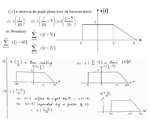dzafar
Member level 4
Hello there,
Below is the question and my attempted solution. My concern regards part 1, 2, 3 and 4.

Q1. I think 1 and 2 are correct, right?
Q2. For 3, if I do time scaling followed by replacing t by t - 5, I get another graph. Which approach should I use? How do I know if I should time scale first or time shift?
Q3. I have no idea what is asked as well as what to do in part 4?
Thanks
Below is the question and my attempted solution. My concern regards part 1, 2, 3 and 4.

Q1. I think 1 and 2 are correct, right?
Q2. For 3, if I do time scaling followed by replacing t by t - 5, I get another graph. Which approach should I use? How do I know if I should time scale first or time shift?
Q3. I have no idea what is asked as well as what to do in part 4?
Thanks
Last edited: